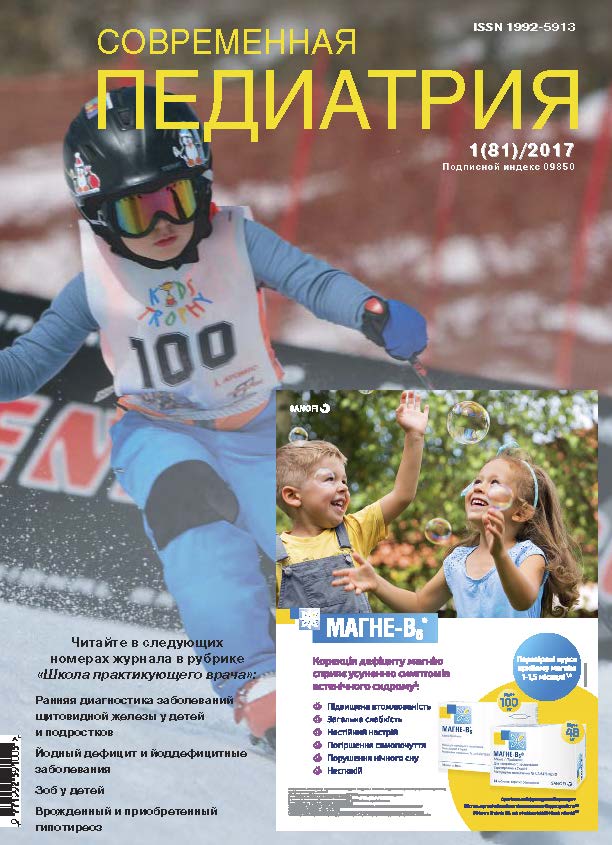Проблемы, связанные с репродуктивным потенциалом девочек из зоны военного конфликта
DOI:
https://doi.org/10.15574/10.15574/SP.2017.81.34Ключевые слова:
репродуктивный потенциал, дети, переселенцыАннотация
Цель: определить состояние репродуктивного потенциала у детей из зоны антитеррористической операции, находящихся на лечении в ГУ «ИОЗДП НАМН».
Пациенты методы. Обследовано 158 девочек 7–17 лет, находящихся на лечении в различных отделениях института. Оценку физического развития проводили с использованием центильных таблиц, рассчитывали индекс массы тела.
Стадии полового развития выделены в соответствии с классификацией J. Tanner (1969).
Результаты. Проведение целевого гинекологического обследования когорты девочек из зоны военного конфликта позволило установить высокий уровень нарушений полового созревания и расстройств менструальной функции. Выявлено, что среди диагнозов преобладают функциональные отклонения, чаще всего в форме гипоменструального синдрома (олигоменореи и вторичной аменореи).
Выводы. Половое развитие — это динамический процесс, который следует рассматривать как один из основных информативных критериев здоровья детского населения. Своевременное выявление отклонений в половом развитии, становлении менструальной функции и их коррекция повышают уровень здоровья и обеспечивают сохранение и укрепление репродуктивного потенциала.
Библиографические ссылки
Vitrishchak SV, Klimenko AK, Savina YeL. 2013. Features of reaction of child's organism to adverse environmental factors. Ukrainskiy medichniy almanakh. 16(1): 7−11.
Volodin AS, Volfson SD, Zhukov SV. 2015. Features of rehabilitation of teenagers, who arrived from the zone of social disaster. Fundamentalnye issledovaniya. 1−2: 240−244.
Gurkin YuA, Feoktistov SS, Shapkayts VA. 2015. The problem of providing gynecological care for girls from migrant families. Pediatr. 6(1): 68−70.
Korolyuk YeG. 2011. Photoautomat reduce the level of health of the child, under conditions of chronic social stress. Vestnik novykh meditsinskikh tekhnologiy. 18 (4): 270−272.
Lіbanova YeM. 2014. Displacement from the Donbass: the scope and challenges for Ukraine (materials of scientific report at meeting of Presidium of NAS of Ukraine 8 October 2014. Vіsnik NAN Ukraini. 12: 15−24.
Gustovarova TA, Sharapova GM, Ivanyan AN, Novikova OV. 2010. Peculiarities of pregnancy and delivery in women-settlers in Kaliningrad region. Vestnik Smolenskoy meditsinskoy akademii. 4: 16−18.
Dedov II, Melnichenko GA, Chebotareva TV. 2006. Sexual development of children and adolescents of Moscow region: effect of obesity.MRZh. 2: 1872.
Levenets SO, Nachotova TA, Perevozchikov VV. 2010. The prevalence of disorders of the function of the reproductive system among modern girls and teenage girls and their risk factors. PAG. 6: 94−96.
Silaeva YeB, Panshina MV. 2013. Effect of correction of adaptation programmes on fertility the woman's body. Vestnik novykh meditsinskikh tekhnologiy. 20 (3): 145−152.
Sіlіna TM, Bukhanovskaya TM, Palamarchuk DV. 2016. The impact of medical social factors on reproductive health of adolescent girls. Ukraine. Zdorov’ya natsіi. 3 (39): 36−40.
Levenets SO, Nachotova TA, Perevozchikov VV. 2009. The formation of the menstrual function, the frequency and risk factors of its disorders in modern girls.Zdorove zhenshchiny. 8 (44): 220−222.
Tsybulskaya IS, Khatsieva MS. 2009. Health and reproduction of the population among migrants from the Chechen Republic (1999-2004) in comparison with similar figures for 1985-1998. Sotsialnye aspekty problemy naseleniya. 9(1): S. 3-5.
Najlaa F Al-Jassar, Lamia Dhia Al-Deen, Najat M Al- Bayatti, Menahel N Al Qadhi. 2006. Age of Menarche in a Sample of Iraqi Girls and Associated Factors. Iraqi J Comm Med. 19(2): 108−112.
Reese Masterson A, Usta J, Gupta J, Ettinger AS. 2014. Assessment of reproductive health and violence against women among displaced Syrians in Lebanon. BMC Womens Health. 14 (1): 25. https://doi.org/10.1186/1472-6874-14-25; PMid:24552142 PMCid:PMC3929551
Chynoweth SK. 2008. The need for priority reproductive health services for displaced Iraqi women and girls. Reprod Health Matters. 16(31): 93−102. https://doi.org/10.1016/S0968-8080(08)31348-2
Bau AM, Rosario AS, Wiegand S, Martus P, Schenk L. 2011. Relevance of age-related growth references: Variations in body measurements among girls in relation to their menarche status. Journal of Public Health. 19(3): 215−222. https://doi.org/10.1007/s10389-010-0381-3
Tanner JM, Davies PSW. 1985. Clinical longitudinal standards for height and height velocity for North American children. The Journal of Pediatrics. 107(3): 317−329. https://doi.org/10.1016/S0022-3476(85)80501-1
Byrskog U, Olsson P, Essén B, Allvin MK. 2014. Violence and reproductive health preceding flight from war: accounts from Somali born womenin Sweden. BMC Public Health. 14: 892. https://doi.org/10.1186/1471-2458-14-892; PMid:25174960 PMCid:PMC4168062
World Health Organization. 1995. World Health Organization Expert Committee. Physical Status, the Use and Interpretation of Anthropometry. Geneva, Switzerland. 263−311.

